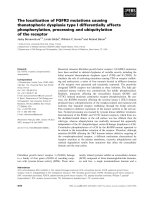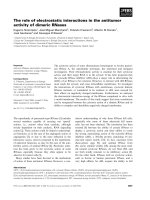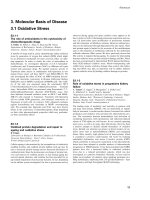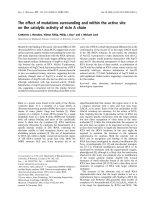báo cáo khoa học: " The impact of citrate introduction at UK syringe exchange programmes: a retrospective cohort study in Cheshire and Merseyside, UK" doc
Bạn đang xem bản rút gọn của tài liệu. Xem và tải ngay bản đầy đủ của tài liệu tại đây (227.09 KB, 6 trang )
BioMed Central
Page 1 of 6
(page number not for citation purposes)
Harm Reduction Journal
Open Access
Research
The impact of citrate introduction at UK syringe exchange
programmes: a retrospective cohort study in Cheshire and
Merseyside, UK
Caryl M Beynon*, Jim McVeigh, Martin Chandler, Michelle Wareing and
Mark A Bellis
Address: Centre for Public Health, Faculty of Health and Applied Social Sciences, Liverpool John Moores University, Castle House, North Street,
Liverpool, L3 2AY, UK
Email: Caryl M Beynon* - ; Jim McVeigh - ; Martin Chandler - ;
Michelle Wareing - ; Mark A Bellis -
* Corresponding author
Abstract
Background: In 2003, it became legal in the UK for syringe exchange programmes (SEPs) to
provide citrate to injecting drug users to solubilise heroin. Little work has been undertaken on the
effect of policy change on SEP function. Here, we examine whether the introduction of citrate in
Cheshire and Merseyside SEPs has altered the number of heroin/crack injectors accessing SEPs, the
frequency at which heroin/crack injectors visited SEPs and the number of syringes dispensed.
Methods: Eleven SEPs in Cheshire and Merseyside commenced citrate provision in 2003. SEP-
specific data for the six months before and six months after citrate was introduced were extracted
from routine monitoring systems relating to heroin and crack injectors. Analyses compared all
individuals attending pre and post citrate and matched analyses only those individuals attending in
both periods (defined as 'longitudinal attenders'). Non-parametric tests were used throughout.
Results: Neither new (first seen in either six months period) nor established clients visited SEPs
more frequently post citrate. New clients collected significantly less syringes per visit post citrate,
than pre citrate (14.5,10.0; z = 1.992, P < 0.05). Matched pair analysis showed that the median
number of visits for 'longitudinal attenders' (i.e. those who attended in both pre and post citrate
periods) increased from four pre citrate to five post citrate (z = 2.187, P < 0.05) but the number
of syringes collected remained unchanged. These changes were not due to seasonal variation or
other changes in service configuration.
Conclusion: The introduction of citrate did not negatively affect SEP attendance. 'Longitudinal
attenders' visited SEPs more frequently post citrate, providing staff with greater opportunity for
intervention and referral. As the number of syringes they collected each visit remained unchanged
the total number of clean syringes made available to this group of injectors increased very slightly
between the pre and post citrate periods. However, new clients collected significantly less syringes
post citrate than pre citrate, possibly due to staff concerns regarding the amount of citrate (and
thus syringes) to dispense safely to new clients. These concerns should not be allowed to negatively
impact on the number of syringes dispensed.
Published: 11 December 2007
Harm Reduction Journal 2007, 4:21 doi:10.1186/1477-7517-4-21
Received: 29 November 2006
Accepted: 11 December 2007
This article is available from: />© 2007 Beynon et al; licensee BioMed Central Ltd.
This is an Open Access article distributed under the terms of the Creative Commons Attribution License ( />),
which permits unrestricted use, distribution, and reproduction in any medium, provided the original work is properly cited.
Harm Reduction Journal 2007, 4:21 />Page 2 of 6
(page number not for citation purposes)
Background
Syringe exchange programmes (SEPs) were established in
the United Kingdom (UK) in the 1980s in response to the
arrival of HIV infection and concerns regarding its trans-
mission through the sharing of injecting paraphernalia.
Such policies were driven by a public health perspective
which regarded the prevention of the spread of HIV infec-
tion to be more important than preventing any potential
drug users from injecting [1]. While it was legal to supply
clean needles and syringes, supplying a person with any
other article which the supplier believed the recipient may
use to administer unlawful drugs, or prepare unlawful
drugs for administration, remained an illegal activity. In
2002 the Advisory Council on the Misuse of Drugs
(ACMD) were asked to consider the harm reduction ben-
efits of drug paraphernalia other than syringes and nee-
dles. The following year, the ACMD recommendations
were accepted and, on 1
st
August 2003, it became legal to
supply ampoules of water, swabs, utensils for drug prepa-
ration (spoons, cups etc.), citrate and filters [2].
The majority of drug users who use SEPs in England to
obtain clean injecting equipment are injectors of heroin
and the majority of these will inject 'brown' heroin [3].
Brown heroin is sold in poorly soluble base form and
most injecting drug users will use an acidifier (for example
citric, ascorbic and lactic acids) to chemically convert it to
a soluble injectable form [4]. Readily available forms of
these acids include fresh and processed lemon juice, vine-
gar and other household products but injecting such sub-
stances have reportedly resulted in infections such as
endocarditis (infection of the heart valves) and endop-
thalmitis (infection of the eyes, [5]).
No acidifier can be considered safe, but citrate is believed
to be the safest to use for the preparation of brown heroin
[6]. Whilst the provision of citrate sachets is relatively new
in the UK its availability in other European countries is
reported to have increased the use of SEPs, reduced the use
of more dangerous acidifiers, has been popular with
injecting drug users and has improved their relationship
with SEP staff [7]. Whilst it was hoped that the introduc-
tion of citrate sachets would increase both the number of
people attending SEPs and the number of visits they made
[6], to date this has not been evaluated within the UK.
Therefore, here we use an established syringe exchange
monitoring system to compare SEP profiles of clients
attending in the six months pre citrate and six months
post citrate and examine whether introducing citrate has
altered: the number of heroin/crack injectors accessing
SEPs; the number of times heroin/crack injectors visit
SEPs and the number of syringes dispensed per visit.
Methods
Cheshire and Merseyside has a population of 2,345,077
(4.7% of England) and its drug users are served by 15 SEPs
based within drug services (pharmacy based SEPs are also
available). Of these, 11 were identified as introducing cit-
rate between May 2003 and October 2004 and conse-
quently were included in the study.
Details of the SEP monitoring system, established in
Cheshire and Merseyside in 1991, are reported elsewhere
[8]. This well-established monitoring system, using the
principles of the National Drug Treatment Monitoring
System within England for the collection of data on struc-
tured drug treatment service provision [9], enables each
syringe transaction to be attributed to a specific individual
and service. An individual is identified by their attributor
code comprised of their initials, date of birth and gender
[8].
Each of the 11 participating SEPs were contacted to iden-
tify the exact date that citrate provision commenced. Mon-
itoring data for the six months pre citrate and post citrate
were extracted individually for each of the 11 SEPs. Within
each six months (i.e. pre citrate and post citrate sepa-
rately), attributor codes were used to aggregate an individ-
ual's transactions into a single client profile for people
who had attended SEPs to collect clean syringes. Again,
within each six-month period, individuals were identified
as either a 'new' client (no previous contact with the SEP)
or an 'established' client (previous contact with the SEP
between 1991 and the six months in question). Final per-
son-specific pre and/or post citrate profiles for each SEP
included age at most recent SEP contact, gender, the cli-
ents main injected drug, their number of visits and the
median number of syringes collected per visit.
Individuals whose main injected drug was heroin or crack
cocaine and who were recorded as having collected clean
syringes on at least one occasion during either six month
period were included in the analyses. Final SEP-specific
profiles for pre and post citrate periods comprised the
number of individuals, median number of visits per client
and median syringes collected per visit for both new and
established clients. In addition to comparing pre and post
citrate profiles, individuals who were identified in both
pre and post citrate periods were included in matched pair
analyses, where an individual's pre citrate profile was
compared with their own profile for the post citrate
period. For the purpose of this study, individuals included
in matched analyses are termed 'longitudinal attenders'
because they were recorded in both pre and post citrate
periods. It is worth noting, however, that these longitudi-
nal attenders may only have visited a SEP once in each six
month period.
Harm Reduction Journal 2007, 4:21 />Page 3 of 6
(page number not for citation purposes)
Two additional analyses were necessary to assess whether
any observed changes pre versus post citrate were related
to natural seasonal variation or other changes in service
configuration. Therefore all heroin/crack SEP injectors
recorded in the post citrate period were matched with
their own SEP profiles for the corresponding time period
12 months previously (n = 314 matched pairs) and the
median number of visits and syringes collected compared.
Finally, pre and post citrate profiles for anabolic steroid
injectors were extracted using the same six month pre and
six month post citrate protocol detailed for heroin and
crack injectors (n = 295 matched pairs). It was hypothe-
sised that, because steroid users do not use an acidifier,
there would be no significant difference in the median
visit rate or median number of syringes collected pre ver-
sus post citrate.
Statistical analyses
Kolmogorov-Smirnov tests showed that age, the number
of visits and the number of syringes collected were all sig-
nificantly, positively skewed, with the exception of the age
of new clients. Non-parametric tests have therefore been
used throughout with Wilcoxon sign rank tests used for
matched, and Mann Whitney U for unmatched, data. Chi
square analyses were used to compare categorical data and
all analyses were undertaken using SPSS version 12 [10] or
EpiInfo version 6 (for chi square [11]).
Results
Comparing pre and post citrate periods, there was no sig-
nificant difference in the age and gender of either new or
established SEP clients (Table 1). The median number of
syringes collected per visit by new clients significantly
decreased from 14.5 syringes pre citrate to 10 syringes
post citrate (P < 0.05). All other variables did not differ
significantly pre versus post citrate.
Table 2 reports findings from the matched pair analyses
for longitudinal attenders of SEPs. The number of syringes
collected by heroin/crack injectors did not differ between
pre versus post citrate and the median visit rate signifi-
cantly increased from four visits pre citrate to five visits
post citrate. Matched pair analyses comparing the profiles
of heroin/crack injectors post citrate with their own corre-
sponding profile 12 months previously showed no differ-
ence in the median number of syringes collected per visit,
but a significant increase in the median number of visits
made per person was observed (P < 0.005). Matched pair
analyses comparing steroid injector profiles pre versus
post citrate showed no difference in the median number
of visits made per client and the median number of clean
syringes collected.
Discussion
Worldwide there are an estimated 13.2 million injecting
drug users [12]. In addition to the high risk of overdose
amongst this group [13,14], drug users who choose to
inject are particularly vulnerable to a range of infectious
diseases, including viral infections such as HIV and hepa-
titis, and bacterial infections such as Group A Streptococci
and Staphlococcus aureus, resulting in considerable levels of
morbidity and mortality [15]. Growing concern regarding
these injecting-related health problems is reflected in
recent changes in the UK law, which in 2003, sanctioned
the dispensing of injecting paraphernalia reported to have
harm reduction benefits, in addition to the provision of
Table 1: Pre versus post citrate comparisons in 11 syringe exchange programmes in Cheshire and Merseyside, UK
Six Month Reporting Period
Established clients New clients
Pre citrate Post citrate Pre citrate Post citrate
nn
Individuals 584 544 258 258
Visits 3485 3734 806 854
Total syringes collected 82101 80074 16947 13059
%%
Male 83.6 84.4 82.6 78.3
Median (Interquartile range) Median (Interquartile range)
Age 33.72 (29.89, 38.02) 34.39 (30.43, 38.25) 32.46 (27.75, 36.86) 31.97 (27.67, 35.72)
Visits per person 3 (1, 8) 3 (1, 9) 2 (1, 4) 2 (1, 4)
Syringes collected per
person
15 (10, 30) 15 (9.25, 27.5) 14.5 (7.88, 25.0) 10 (6.5, 20.0)
1
1
Significant at the <0.05 level
Harm Reduction Journal 2007, 4:21 />Page 4 of 6
(page number not for citation purposes)
clean needles and syringes. Under these amendments, it
became legal in the UK to provide citrate to injecting drug
users, a substance shown to be an appropriate means by
which to convert street heroin into a soluble form [3].
It was envisaged that the introduction of citrate would
increase both the number of injectors attending SEPs and
the number of visits each person made [6]. The recently
updated guidance on the commissioning and provision of
treatment for adult drug users [16] highlights the need for
the reinvigoration of harm reduction activities across all
treatment tiers (drug-related interventions in England and
Wales fall into a tier structure that reflects the increasing
intensity of the interventions). Increasing the number of
individuals in contact with SEPs and the frequency of their
engagement are positive public health indicators for harm
reduction development. Analysis of SEP monitoring data
showed no increase between pre and post citrate periods
in the number of established or new clients. Importantly
however, there was no significant decrease either, showing
that the introduction of citrate had not negatively affected
attendance.
Monitoring data also showed no significant increase in
the frequency with which heroin/crack injectors attended
SEPs following citrate's introduction. The median number
of visits made by established clients was three in both pre
and post citrate periods while new clients made, on aver-
age, two visits within each of the two six month periods.
However, matched pair analyses of longitudinal attenders
of SEPs, comparing an individual's post citrate profile
with their own behaviour pre citrate, showed that this
cohort of injectors made significantly more visits post cit-
rate (median = 5) than pre citrate (median = 4, P < 0.05).
Further to this, matched pair analyses showed the median
visits per person post citrate (median = 5) was signifi-
cantly greater than the median visits for the corresponding
six months in the previous year (median = 4, P < 0.005),
for those injectors who were recorded in these two six
month periods. We can therefore discount the possibility
that the increase in visit rate between pre and post citrate
was due to seasonal variation because the increased visit
rate following the introduction of citrate occurred across
years as well as within the year. Additionally, again using
matched pair analysis, we observed no difference in the
median number of visits pre and post citrate for steroid
injectors (median number of visits being one in both the
pre and post citrate periods). Steroid users do not use an
acidifier so their behaviour should not be affected by the
introduction of citrate. That no change in the behaviour of
Table 2: Impact of citrate introduction in 11 syringe exchange programmes in Cheshire and Merseyside, UK
Six Month Reporting Period
12 months pre citrate
1
Pre citrate Post citrate
Median (Interquartile range)
Established matched pairs (n = 398)
Visits per person 4 5
(2, 10) (2, 11)
2
Syringes collected per person 15 15
(10, 30) (10, 25)
Seasonal matched pairs (n = 314)
Visits per person 4 5
(2, 9) (2.75, 12.25)
3
Syringes collected per person 15 20
(10, 30) (10, 30)
Steroid matched pairs (n = 295)
Visits per person 1 1
(1, 2) (1, 2)
Syringes collected per person 30 30
(20, 36) (20, 40)
1
12 months pre citrate' corresponds to the post citrate period, 12 months previously and has been used as a control to asses the possibility that any
differences between pre and post citrate were due to natural seasonal variations.
2
Significant at the <0.05 level
3
Significant at the <0.005 level
Harm Reduction Journal 2007, 4:21 />Page 5 of 6
(page number not for citation purposes)
steroid injectors was observed supports the conclusion
that the increased visit rate post citrate of heroin/crack
injectors who attended SEPs in both pre and post citrate
periods was due to the introduction of citrate. It is impor-
tant to note, however, that the legal changes that permit-
ted the distribution of citrate also sanctioned the
distribution of other injecting paraphernalia (for exam-
ple, spoons and water), although the distribution of other
paraphernalia in SEPs in Cheshire and Merseyside
occurred less consistently than the introduction of citrate.
Despite this, it is possible that the distribution of other
injecting paraphernalia also affected the behaviour of SEP
attenders within this geographical area.
From these findings, we can conclude that the introduc-
tion of citrate did not encourage more clients to contact
SEPs to collect clean injecting equipment in the first six
months of its introduction, nor can we conclude that its
introduction negatively affected attendance. Furthermore,
we cannot conclude that overall, people visited SEPs more
frequently following the introduction of citrate but that its
introduction has encouraged longitudinal attenders of
SEPs (i.e. those who were recorded in both the pre and
post citrate six month periods) to visit more frequently.
Therefore, at SEPs included in this study, the introduction
of citrate has resulted in a change in service use amongst
certain SEP clients, with less impact on those injectors
who visit SEPs infrequently. Any increase in visit fre-
quency should be welcomed as it provides SEP staff
greater opportunity to engage with injectors to discuss a
range of harm reduction measures and, where appropri-
ate, to refer into other services. It is not clear from this
study whether further changes will be observed once
information about the availability of citrate at SEPs
becomes universal amongst the injecting community.
With respect to the number of syringes collected per visit,
no difference was evident pre versus post citrate for estab-
lished SEP clients. Matched pair analysis showed compa-
rable findings. Similarly, no difference was observed in
the number of syringes collected for heroin/crack injectors
post citrate compared to the corresponding six month
period in the previous year or for steroid injectors pre ver-
sus post citrate. Established SEP clients are therefore con-
tinuing to receive the same number of syringes per visit
and, presumably, sufficient citrate for the number of
syringes dispensed. Injectors who are classified as 'longi-
tudinal attenders' for the purpose of this study, are thus
attending SEPs more frequently post citrate but collecting
the same number of syringes per visit, increasing, very
slightly, the total number of syringes dispensed to this
cohort of injectors from 71,495 in the pre citrate six
month period to 71,743 in the post citrate six month
period (data not shown). In light of evidence to suggest
that clean syringes are used in only 25% of injections [17],
from a public health perspective, any increase in syringe
provision is welcome.
Despite the benefits of citrate over other acidifiers [7], all
may result in vein damage and the smallest possible
amount is recommended to solubilise heroin. Consulta-
tion with injecting drug users resulted in the current prac-
tice of dispensing citrate in 100 mg sachets [6]. This
amount was deemed sufficient to dissolve the £20 of her-
oin normally prepared and because packaging a smaller
amount would be unfeasible. Injectors liked the idea of
single use sachets which were also deemed to decrease the
risk of contamination from sharing whilst encouraging
hygienic injecting techniques. Monitoring data showed
that SEP staff dispensed significantly less syringes to new
clients per visit post citrate (median = 10 per visit) than
pre citrate (median = 14.5 per visit, P < 0.05). While it is
important that SEP staff are aware of the potential harm
excess citrate may cause, fears regarding the dispensation
of too much citrate to new clients must not be allowed to
impact negatively on the number of clean syringes dis-
pensed.
Conclusion
While citrate may be the safest acidifier for drug users to
prepare heroin for injection, hopes that its introduction
would increase the number of injectors accessing SEPs
were not supported by this study. Importantly, however,
the introduction of citrate did not negatively affect attend-
ance either, indicating that citrate can be added to the
spectrum of interventions offered by SEPs without any
apparent negative consequences. Furthermore, injectors
who already attended SEPs relatively frequently on a lon-
gitudinal basis (i.e. in both pre and post citrate periods),
attended SEPs more frequently, providing evidence to
support a positive change in service use among these par-
ticular individuals. Greater levels of engagement provide
increased opportunities for interaction between the inject-
ing drug user and the practitioner. This can facilitate a
range of harm reduction interventions relating to the pre-
vention of blood borne infections and improvements in
injecting techniques. In addition, increased contact rates
can provide opportunities for appropriate referral to both
specific drug-related interventions and generic health and
welfare support. Furthermore, the increased number of
syringe exchange visits, without a reduction in the
number of syringes provided at each visit, within this cli-
ent group, has slightly increased the number of clean
syringes in circulation. Increasing the number of clean
syringes distributed, to enable the use of sterile equipment
for each injection, should remain a public health target
and developments to facilitate this should be supported.
Staff concerns regarding the amount of citrate to dispense
to new clients must not impact on the number of syringes
given out. It is not clear from this study whether further
Publish with Bio Med Central and every
scientist can read your work free of charge
"BioMed Central will be the most significant development for
disseminating the results of biomedical research in our lifetime."
Sir Paul Nurse, Cancer Research UK
Your research papers will be:
available free of charge to the entire biomedical community
peer reviewed and published immediately upon acceptance
cited in PubMed and archived on PubMed Central
yours — you keep the copyright
Submit your manuscript here:
/>BioMedcentral
Harm Reduction Journal 2007, 4:21 />Page 6 of 6
(page number not for citation purposes)
changes have been observed at SEPs once information
about the availability of citrate became ubiquitous among
drug injectors. Finally, this study demonstrates the value
of utilising routinely collected monitoring data to assess
the impact of harm reduction interventions, with further
analyses planned to evaluate the longer-term impact of
citrate provision at SEPs.
Competing interests
The author(s) declare that they have no competing inter-
ests.
Authors' contributions
CMB carried out data extraction, performed the statistical
analyses and wrote the manuscript. JM conceived of the
study, participated in its design and was involved in writ-
ing the manuscript. MC coordinated acquisition of data
and assisted in writing the manuscript. MW participated
in writing the manuscript. MAB provided assistance with
the statistical analyses and interpretation and helped to
revise the manuscript. All authors read and approved the
final manuscript.
Acknowledgements
We would sincerely like to thank staff working in syringe exchange pro-
grammes for their efforts in reporting data to the Centre for Public Health
(CPH). Thanks are also extended to those Cheshire and Merseyside Drug
(and Alcohol) Action Teams who financially support the Inter Agency Drug
Misuse Database (IAD) and staff within the CPH who run the IAD. Finally,
we would like to thank all three reviewers and Mark Whitfield, CPH, for
their comments on this manuscript. There was no specific funding for this
piece of work.
References
1. Advisory Council on the Misuse of Drugs: Aids and Drug Misuse
part I. London , Home Office; 1988.
2. Exchange Supplies: Exchange Supplies. Paraphernalia and the
law. [ />paraphernalia_law.html#section9a].
3. Scott J, Winfield A, Kennedy E, Bond C: Laboratory study of the
effects of citric and ascorbic acids on injections prepared
with brown heroin. Int J Drug Policy 2000, 11(6):417-422.
4. Strang J, Keaney F, Butterworth G, Noble A, Best D: Different
forms of heroin and their relationship to cook-up techniques:
data on, and explanation of, use of lemon juice and other
acids. Subst Use Misuse 2001, 36(5):573-588.
5. Gallo J, Playfair J, Gregory-Roberts J, Grunstein H, Clifton-Bligh P, Bill-
son F: Fungal endophthalmitis in narcotic abusers. Medical
and surgical therapy in 10 patients. Med J Aust 1985,
142(7):386-388.
6. Garden C, Roberts K, Taylor A, Robinson D: Evaluation of the
provision of single use citrate acid sachets to injecting drug
users. Edinburgh: Effective Interventions Unit (Scottish Executive);
2003.
7. Preston A, Derricott J: Citrate Briefing 2nd Edition. Dorches-
ter. Exchange Supplies; 2002.
8. McVeigh J, Beynon C, Bellis MA: New challenges for agency
based syringe exchange schemes: analysis of 11 years of data
(1991 - 2001) in Merseyside and Cheshire, United Kingdom.
Int J Drug Policy 2003, 14:399 -3405.
9. National Treatment Agency for Substance Misuse: National Treat-
ment Agency for Substance Misuse. Statistics from the
National Drug Treatment Monitoring System (NDTMS) 1
April 2004 – 31 March 2005. London: NTA; 2006.
10. SPSS Inc.: SPSS Base 10.0 for Windows Users' Guide. Chicago
, SPSS Inc.; 1999.
11. Dean AG, Dean JA, Burton AH, Dicker RC: EpiInfo, version 6: a
word processing, database and statistical program for epide-
miology on microcomputers. Atlanta , Centres for Disease Con-
trol; 1999.
12. Aceijas C, Stimson GV, Hickman M, Rhodes T: Global overview of
injecting drug use and HIV infection among injecting drug
users. Aids 2004, 18(17):2295-2303.
13. Strang J, Powis B, Best D, Vingoe L, Griffiths P, Taylor C, Welch S,
Gossop M: Preventing opiate overdose fatalities with take-
home naloxone: pre-launch study of possible impact and
acceptability. Addiction 1999, 94(2):199-204.
14. Strang J, Best D, Man L, Noble A, Gossop M: Peer-initiated over-
dose resuscitation: fellow drug users could be mobilised to
implement resuscitation. Int J Drug Policy 2000, 11(6):437-445.
15. Health Protection Agency, Health Protection Scotland, National Pub-
lic Health Service for Wales, CDSC Northern Ireland, CRDHB,
UASSG: Shooting Up; Infections among injecting drug users
in the United Kingdom in 2004. London , Health Protection
Agency; 2005.
16. National Treatment Agency for Substance Misuse: National Treat-
ment Agency for Substance Misuse. Models of care for treat-
ment of adult drug misusers: Updated 2006. London: NTA;
2006.
17. Hickman M, Higgins V, Hope V, Bellis M, Tilling K, Walker A, Henry
J: Injecting drug use in Brighton, Liverpool, and London: best
estimates of prevalence and coverage of public health indica-
tors. J Epidemiol Community Health 2004, 58(9):766-771.
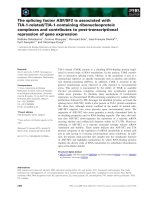
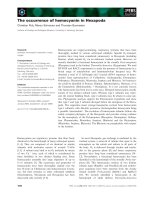
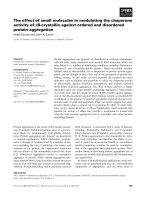
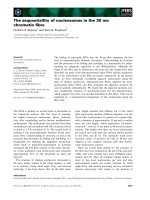
![Tài liệu Báo cáo khoa học: The stereochemistry of benzo[a]pyrene-2¢-deoxyguanosine adducts affects DNA methylation by SssI and HhaI DNA methyltransferases pptx](https://media.store123doc.com/images/document/14/br/gc/medium_Y97X8XlBli.jpg)
